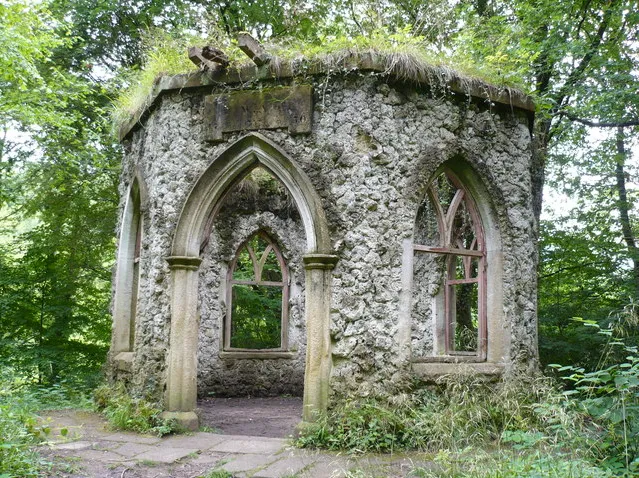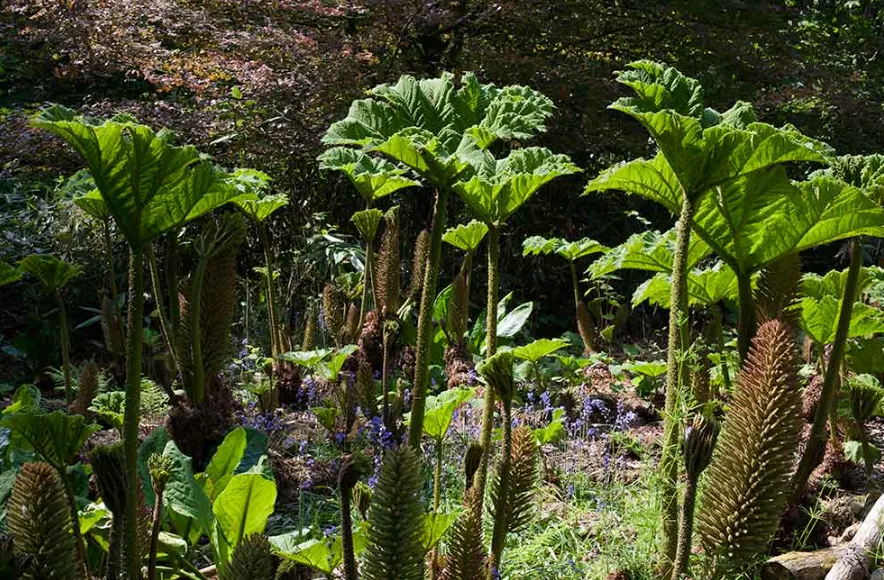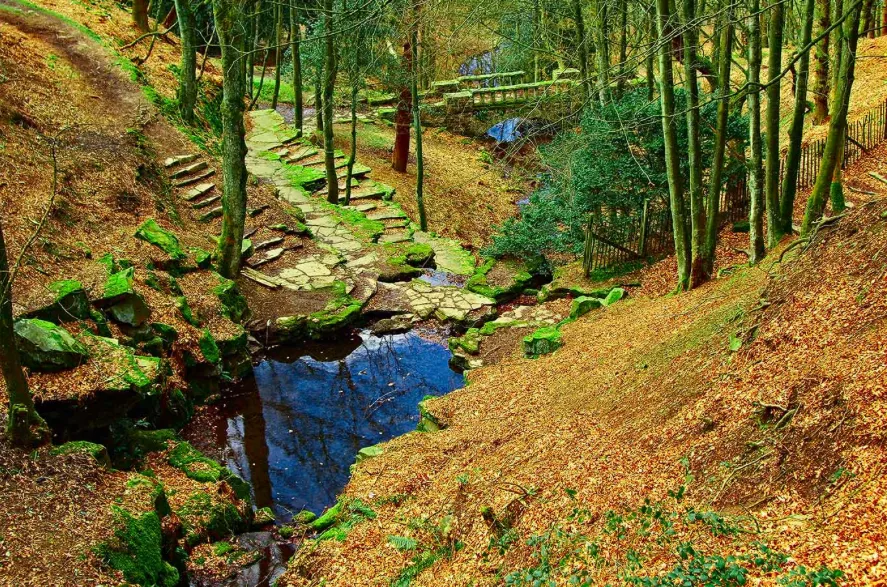1. Belsay Hall, Northumberland
Sir Charles Monck wasted a lot of good sandstone building his severe, neo-classical house, completed in 1817. Once the quarrymen had finished cutting stone from a corner of Monck’s estate, though, they left behind a ravine that is now the glory of Belsay Hall. The quarry garden is a deeply romantic place; its sheer rock faces are a vertical garden of mosses and ferns. The estate also includes impressive rhododendrons and a ruined Jacobean mansion and castle.

Hackfall via Wikipedia
2. Hackfall Wood, North Yorkshire
Created in the 17th century by William Aislabie of Studley Royal – the famous landscape garden nearby – Hackfall attracted notable admirers, including poet William Wordsworth and painter JMW Turner. It was still a popular attraction in the 1930s, but after the Second World War the garden fell into decline. Many of its Gothic garden buildings remain, although in a semi-derelict state, including Mowbray Castle. Yet Hackfall remains a charismatic landscape, set around a deep, wooded, atmospheric gorge, through which the River Ure winds. Although major repairs to the buildings and follies have been necessary, they’ve been undertaken sympathetically.
The residence of the Bishop of Worcester from the 13th century until 2007, Hartlebury Castle’s mysterious gardens have long been shut up, overgrown and neglected. The remarkable relics within its crenellated walls include a Queen Elizabeth walk and series of tangled pools. Who knows what others treasures the strimmers will uncover when restoration begins. Although currently overgrown, this is an opportunity to see a restoration project from the beginning.

Penjerrick Garden via classic.co.uk
4. Penjerrick Garden, Cornwall
Cornwall’s self-styled ‘true jungle garden’ was planted in the 1840s by Robert Were Fox, whose brothers Charles and Alfred created the celebrated gardens of Trebah and Glendurgan nearby. Whereas these two gardens survive in manicured perfection, Penjerrick is a distinctly wilder and more adventurous place to visit. Fox’s exotic trees and shrubs have thrived in this mild and sheltered enclave, creating a dense forest, full of hidden pathways leading through glades of tree ferns, huge rhododendrons, camellias and magnolias, and giants clumps of bamboo. The garden is open from March to September, Wednesday, Friday and Sunday, 1.30pm to 4.30pm. Adults £3, children £1.50 at the honesty box.
5. Lyveden new Bield, Northamptonshire
This half-completed lodge and garden have survived virtually untouched since 1605. Work was abandoned on the death of the estate’s owner, Sir Thomas Treshem, and gradually the land became overgrown. The estate’s orchards have recently been restored and the scrub has now been cleared from the Elizabethan pleasure gardens, revealing a network of canals that together comprise one of few remaining water gardens typical of the 16th century.
6. Myddelton House, London
EA Bowles, the ‘crocus king’ and one of the world’s greatest plantsmen, created these gardens over seven decades, planting them with species he collected abroad. After his death in 1954, the rock garden and man-made river were lost, but the spirit of Bowles lives on in the garden’s collections of irises and crocuses, not to mention the Lunatic Asylum – Bowles’ name for his bed of ‘maniac’ plants, including the corkscrew hazel.

Rivington via About-Rivington
7. Rivington Terraced Gardens, Lancashire
The great Edwardian landscape architect Thomas Mawson regarded these gardens as his finest creation. Their owner, soap magnate Sir William Lever, gave the estate to the people of Bolton in 1902; since then the pagodas and pavilions that once stood on the shores of the Japanese lake have long gone, but this remarkable place is still rich in atmosphere. Surrounded by the Pennine moors and shadowed by Rivington Pike, these 45 acres of parkland are crossed by paths that wind through exotic and native trees, past pools and waterfalls and derelict follies.
8. Belhus Woods Country Park, Essex
Belhus mansion was grand enough to attract a visit from Queen Elizabeth I in 1578, but Luftwaffe bombs damaged the house during the Second World War and, soon after, it was bulldozed. Its remains now preside over the 10th hole of a golf course, but fragments of the surrounding estate, designed by Lancelot ‘Capability’ Brown in the 18th century, remain. Now a country park owned by Essex council, you can wander its woodlands – bright with bluebells in spring – picnic in the grasslands or fish at the lakes.
9. Valleyfield Woodland Park, Fife
This estate, near Shiresmill, was laid out by the great English landscape designer Humphry Repton for Sir Robert Preston in 1802. In 1904, the East Fife Coal Company bought the land for its coal prospects, later abandoning the mansion, which was demolished in 1941. Subsequently, much of the landscape, which was painted by Alexander Nasmyth (1758-1840), has been lost to farmland and urban development. Now owned and managed by Fife Council and opened as a woodland park in 1990, there is still plenty to see at Valleyfield, including the remains of the walled flower garden, ornamental canal, ice house, beech avenue and ha-ha. In late winter, snowdrops fill the woodlands, and guided walks tread a careful path through carpets of naturalised flowers. The woodlands are a public place so you are free to wander at will all year round.
Dewstow Gardens via dewstow.co.uk
10. Dewstow Gardens, Wales
This labyrinth of underground gardens, hidden in tunnels and grottoes, was created by Henry Oakley in 1895 to house his collection of ferns and tropical plants. After the Second World War, the tunnels were filled in, and their sheer extent was only revealed in 2000, when a restoration programme began. The underground network has since been opened up, and the ponds, rills, rock garden, alpine garden have been restored. Although most of the original glasshouses are long gone, some have been rebuilt, and parts of the seven-acre garden are perfectly preserved.